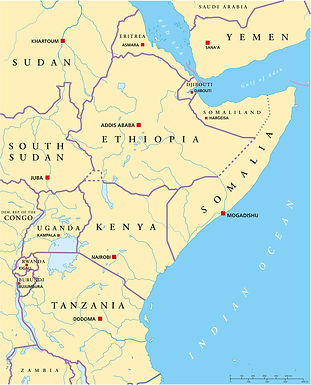East Africa—a country of awe-inspiring natural theatre, from the rolling grasslands of the Maasai Mara to the mystical, primate-studded mountains of the Bwindi Impenetrable Forest. Merging Kenya and Uganda in one itinerary is the height of African adventure, with a perfect marriage of traditional safari, beach relaxation, and busy primate interaction.
Yet, organizing this trip takes more than a quick search for flights and accommodation. The entry regulations have changed, particularly with Kenya's shift to the Electronic Travel Authorization ( Kenya ETA) system. This guide demystifies the confusion, breaking down the required documentation and highlighting the not-to-be-missed activities that lie in store in these two incredible countries.
East Africa's New Gateway: Understanding the Online Kenya ETA
The most notable shift for foreign visitors to Kenya is the substitution of the old eVisa system with the Electronic Travel Authorization (ETA). This is intended to make border control more efficient and add security, but it requires all visitors—whether they are visa required or not—to apply for Kenya ETA prior to their visit.
The Kenya ETA is required of all non-citizens of Kenya and needs to be obtained at least 72 hours prior to your departure, although it is advisable to apply two weeks ahead to allow for processing delays.
Key Kenya ETA Details:
- Who Needs Kenya eTA? Virtually everyone is traveling to Kenya. The only exceptions are specific exempted persons (e.g., East African Community citizens).
- Application Process for Kenya eTA : The application is fully online, requiring passport details, a photograph, flight itinerary, and accommodation details. The key is accuracy; ensure all passport data is entered without errors.
- Kenya eTA Validity: The approved ETA is typically valid for a single entry for a stay of up to 90 days.
- Cost: The cost is generally lower than the previous eVisa, making the entry process more affordable for travelers. Always check the Kenya eTA Fees page for the most current fees.
Online Uganda eVisa System: Your Digital Entry Permit
While Kenya has moved to ETA, Uganda maintains a straightforward eVisa system for most international visitors. Unlike Kenya's blanket ETA, Uganda offers several visa types, with the most common being the Single Entry Tourist Visa.
Applying for the Ugandan eVisa is also done entirely online via the Directorate of Citizenship and Immigration Control portal.
Uganda Visa Types & Considerations:
- Uganda Single Entry Visa: Valid for 90 days. Ideal if Uganda is your sole destination or if you plan to visit only once.
- Uganda Multiple Entry Visa: Available for stays up to 6 or 12 months, suitable for frequent travelers or those planning complex regional itineraries.
- Uganda Transit Visa: For travelers passing through Uganda for less than seven days.
Ensure your passport is valid for at least six months beyond your planned date of departure and has at least two blank pages. You will need to upload a recent passport photo and a copy of your passport bio-data page during the application.
The East Africa Tourist Visa (EATV): One Visa, Three Countries
For anyone combining Kenya and Uganda, the East Africa Tourist Visa (EATV) is a game-changer. This single visa grants you access to Kenya, Uganda, and Rwanda (the three partner countries) for up to 90 days.
- Feature:
Single Visas (ETA/eVisa): Single-country visa
EATV (East Africa Tourist Visa): Covers multiple countries - Countries Covered:
Single Visas: One country each
EATV: Kenya, Uganda, and Rwanda - Re-entry:
Single Visas: Single entry per country
EATV: Allows multiple crossings between the three countries once you enter the first EATV country - Application:
Single Visas: Must apply separately for Kenya and Uganda
EATV: Apply once to the first country you plan to enter
Crucial Note: You must apply for the EATV through the embassy or online system of the first country you intend to enter. For example, if you fly into Nairobi (Kenya) first, you must apply for the EATV through the Kenyan government portal. This is the simplest and most cost-effective solution for a Kenya-Uganda trip.
Kenya Safari Highlight: The Great Migration at Maasai Mara
Kenya is the embodiment of the traditional safari dream, and the Maasai Mara National Reserve is its crown. The chief attraction is the Great Wildebeest Migration, a yearly natural phenomenon in which more than two million wildebeest, zebra, and gazelle walk through the grasslands to find new pasture.
If you can plan your visit between July and October, you have the greatest chance of viewing the spectacular river crossings at the Mara River when crocodiles ambush. Even when not during migration, the Mara has year-round big-five spotting (lion, leopard, elephant, rhino, and buffalo) and stunning sunrise hot air balloon tours.
Beyond the Savannah: Kenya's Coastal Charms (Mombasa & Diani)
Following the arid safari experience of Kenya, there is a different experience along the country's breathtaking Indian Ocean shoreline. The region of Mombasa and Diani Beach is ideal for decompression.
- Diani Beach: Ranked as one of Africa's finest beaches, Diani features silky white sand, aquamarine water, and a tranquil ambiance. Activities extend from kite surfing and snorkeling in the transparent lagoon to a trip to the nearby Colobus Conservation to safeguard native monkeys.
- Marine Parks: Discover the colorful coral reefs of Malindi and Watamu Marine National Parks, ideal for dive enthusiasts. The Swahili culture here offers an intense historical contrast with that of the interior Maasai culture.
Primate Paradise: Gorilla and Chimpanzee Trekking in Uganda
Uganda, known as the "Pearl of Africa," is the world's ultimate primate destination. This is where your experience becomes intensely personal and emotionally powerful.
- Gorilla Trekking: The thrill is following endangered Mountain Gorillas in the cloudy, dense rain forest of Bwindi Impenetrable National Park. Trekking permits are required and strictly limited to conserve the gorillas. Since demand is extremely high, booking your permit 6 to 12 months in advance is necessary. The trek is sometimes arduous—steep and muddy slopes—but the hour spent watching a gorilla family in the wild is simply unforgettable.
- Chimpanzee Tracking: For a more action-packed, high-energy adventure, visit Kibale National Park, with the greatest density of primates in Africa and numerous hundreds of habituated chimpanzees. To observe these bright animals interact, play, and forage in the treetops is absolutely captivating.
Adventure on the Nile: White-Water Rafting and Source Exploration
The town of Jinja, Uganda, located near Lake Victoria, is famed as the historic source of the mighty Nile River. It has established itself as the adventure capital of East Africa.
Here you can experience:
- World-Class Rafting: The stretch of the Nile near Jinja is renowned for its thrilling Grade V rapids, offering full-day or half-day adrenaline-pumping excursions. Safety standards are high, even for beginners.
- Bungee Jumping: For the truly fearless, a jump over the Nile offers a unique view.
- Nile Kayaking: A calmer way to explore the river, often allowing for excellent bird-watching opportunities along the banks.
Cultural Crossroads: Kenyan Tribes and Ugandan Kingdoms
To truly understand East Africa, dedicate time to engaging with its people and ancient traditions.
- The Maasai (Kenya): Known for their striking red shukas (robes), distinctive jumping dances (adumu), and semi-nomadic lifestyle, the Maasai offer cultural village visits near the Maasai Mara. While some are tourist-oriented, a good guide can provide genuine insight into their pastoralist heritage.
- The Buganda Kingdom (Uganda): Unlike Kenya's tribal focus, Uganda has a history rooted in powerful kingdoms. Exploring the Kasubi Tombs (a UNESCO World Heritage Site) in Kampala offers a look into the history and politics of the largest traditional kingdom, the Buganda.
Practical Planning: Combining a Kenya-Uganda Itinerary
A popular route involves flying into Nairobi (Kenya), spending a week on safari and the coast, and then taking a short flight to Entebbe/Kampala (Uganda) for the primate and Nile adventures.
Travel Logistics:
- Inter-Country Flights: Several regional carriers offer affordable and quick flights between Nairobi (NBO) and Entebbe (EBB), which are far faster and more comfortable than long overland drives.
- Currency: The Kenyan Shilling (KES) and Ugandan Shilling (UGX) are the local currencies. US Dollars are widely accepted for major tour operators and park entrance fees, but always carry local currency for small purchases and tips.
- Health: Both countries require proof of a Yellow Fever vaccination, which is a mandatory requirement to enter Uganda and often requested when crossing the border from Kenya.
Security and Responsibility: Sustainable Tourism
Both Kenya and Uganda place a high value on sustainable tourism, especially concerning wildlife conservation. When participating in gorilla or chimpanzee trekking, remember that the high cost of the permits directly funds the conservation efforts and the protection of these endangered species.
Always choose reputable, eco-conscious tour operators who prioritize local employment and respect the strict park regulations. By adhering to the rules—like maintaining distance from the animals and refraining from littering—you ensure that these magnificent destinations remain pristine for future travelers.
The shift to the Kenya ETA and the option of the EATV have made cross-border travel in East Africa more organized and accessible than ever before. With the right preparation for your entry permits and your itinerary set between the majestic plains of Kenya and the lush, primate-filled forests of Uganda, you’re ready for a journey that will redefine your concept of adventure.
Are you planning to focus more on the wildlife (Kenya) or the adventure/primate trekking (Uganda) for your upcoming trip? Let me know, and I can suggest a sample itinerary!










